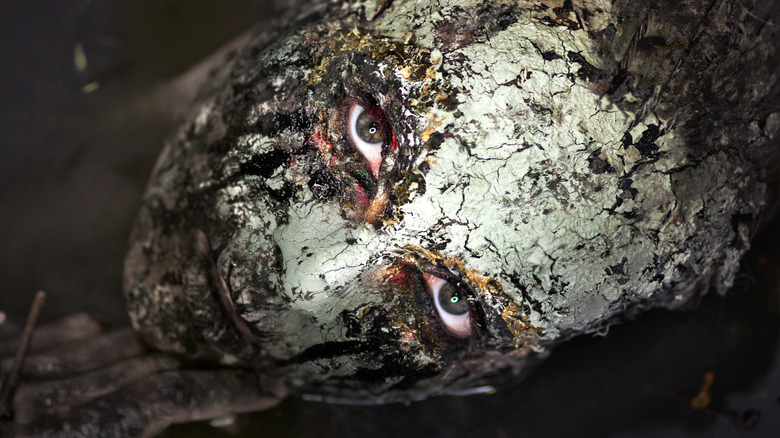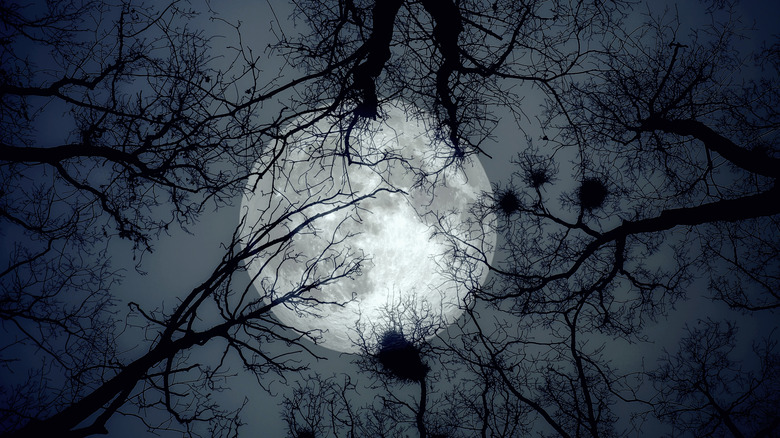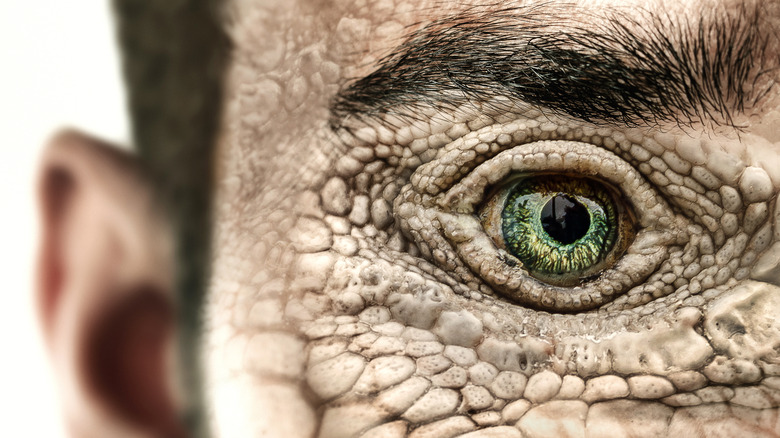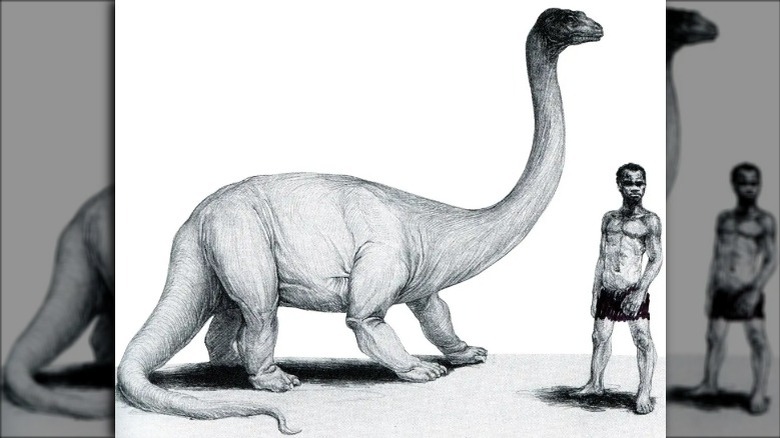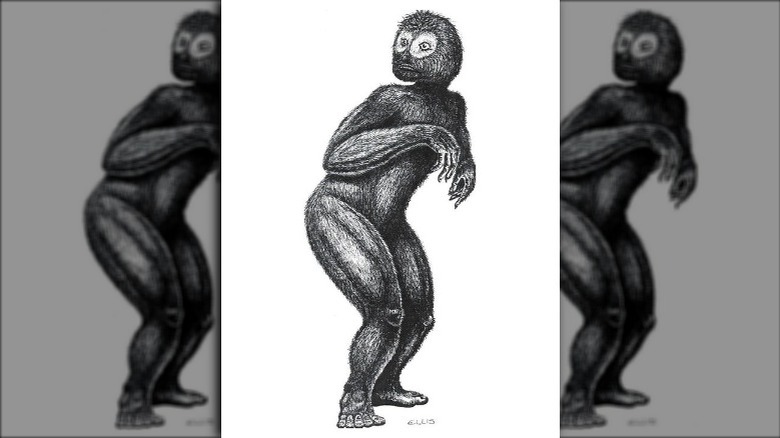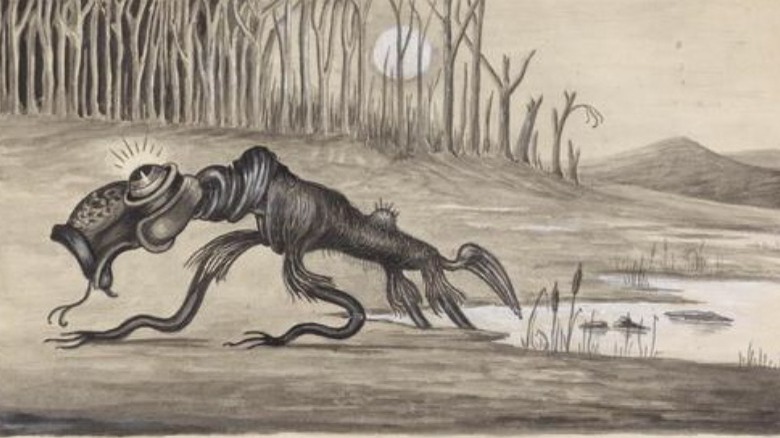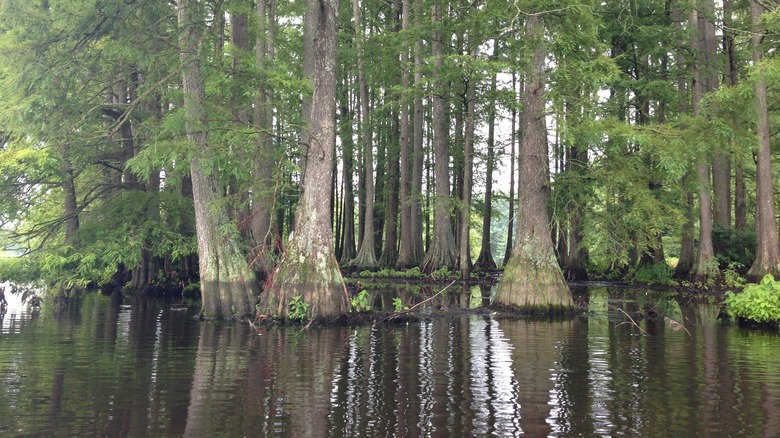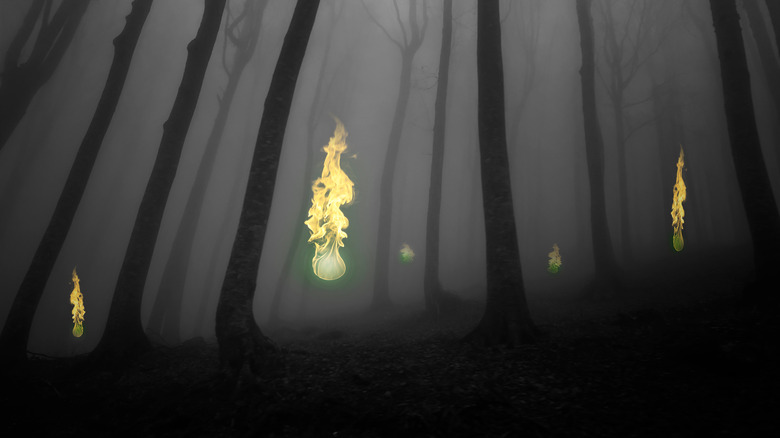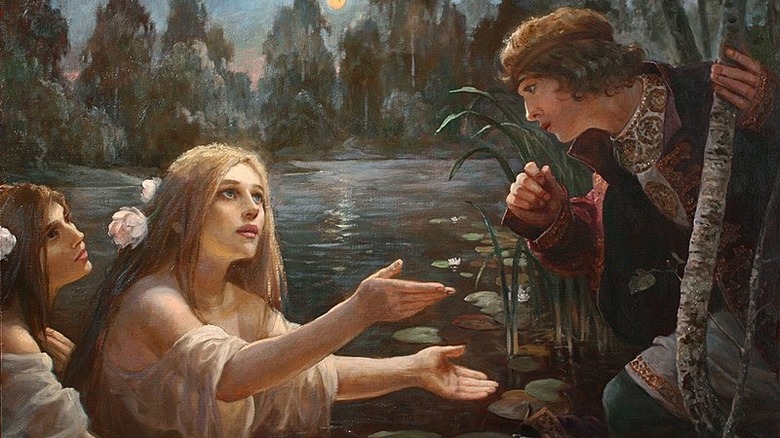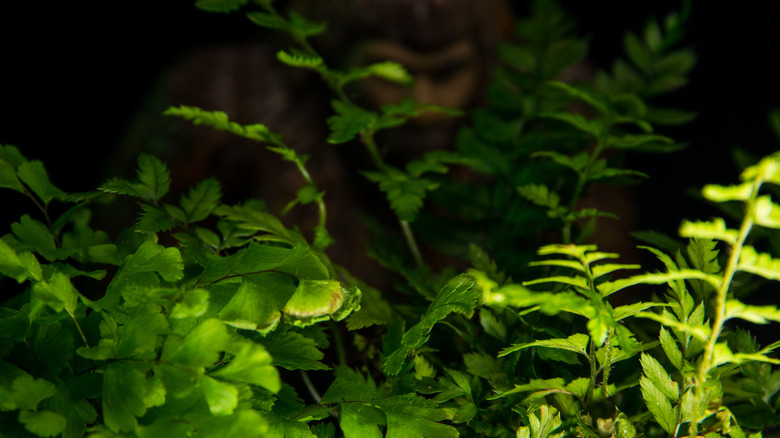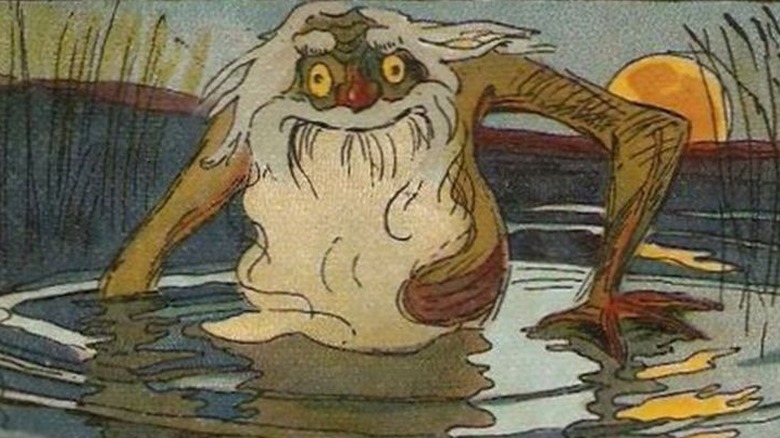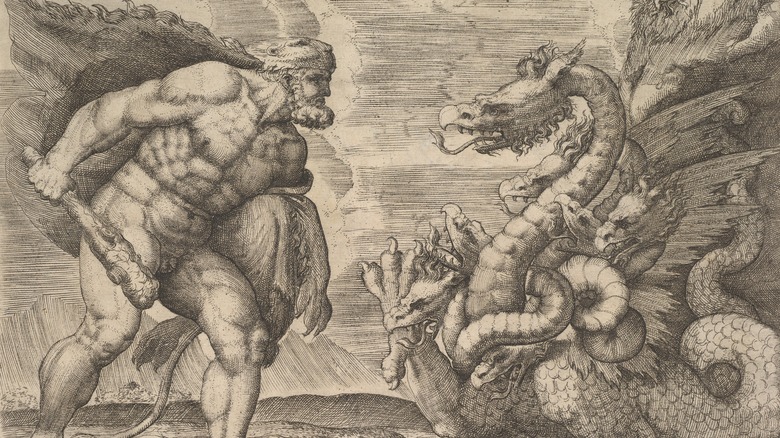Terrifying Swamp Monsters From Around The World
Let's get this out of the way right upfront: Swamps are terrifying. Sure, they're a treasure trove of ecological wonder, providing a rich habitat for everything from mangrove and cypress trees to a myriad of fish, reptiles, and birds. But sometimes there's alligators in there, too, and according to the mythology and folklore that have been building around swamps for millennia, that's just the start of what's living in there.
Swamps don't get enough credit. National Geographic points out that it was a swamp widely known as the Fertile Crescent that gave humankind the chance to flourish in the first place, and it's even where we first developed one of the most important technological advances for our species: the wheel.
But, in spite of our close relationship with the world's swamps, humans have always had a certain amount of suspicion regarding them, too. While Swamp Thing might be the most famous monster that's ever come crawling out to terrorize nearby land-dwellers, he's not the only one. For millennia, we've been telling tales of the terrible monsters that live in the swamps... like these.
Beware of the Louisiana swamps... particularly under a full moon
No trip to Louisiana is complete without a tour of their swamps. They're primal, unspeakably beautiful, and — if the legends are to be believed — particularly dangerous when there's a full moon. The Louisiana swamps have long been said to be the home of a werewolf called the Rougarou, a Cajun version of loup-garou (the old European name for the same creature.) The Rougarou was a type of monster rather than a specific individual, and the stories say they were once ordinary people... who made extraordinary mistakes. NOLA Weekend says there's a few different reasons a person could become a Rougarou: Forgetting to observe Lent for seven years in a row would turn someone into the half-man, half-beast, or, gaining the ire of a Voodoo priestess or a witch might make them angry enough to perform a curse to turn an unlucky person into a howling, bloodthirsty, half-wolf.
Misbehaving children were often threatened with a visit from a hungry Rougarou, but there was a way to at least distract them long enough to flee. Placing 13 objects (usually rocks or pennies) at the door was said to keep the Rougarou busy until sunrise — they could only count to 12.
Pelican State of Mind says that stories of actual sightings don't happen as much as they used to, but Louisiana still celebrates their folklore, heritage, and creepy swamp monster with an annual festival dedicated to the Rougarou ... past and present.
The ire of the Tiddy Mun
Not all swamp-dwelling monsters are inherently evil, and sometimes, they're just trying to live their swamp-dwelling lives when mankind has to come along and ruin it. That, says Storynory, is what happened in the case of the Tiddy Mun.
The Tiddy Mun lived in the fens and bogs in Eastern England, and for a long time, he had a sort of friendly relationship with nearby humans. When swamp waters rose with the rainy season, villagers would call to him: "Tiddy Mun without a name, the water's soaked the earth, again." When the waters would inevitably recede, and the peewit bird would sing, they would thank the tiny but elderly-looking spirit of the bogs (via South Holland Heritage).
That changed in the 17th century, when King Charles I decided it was a brilliant idea to hire Dutch engineers to drain the marshes and turn the areas into more arable land. The locals — and the spirits — chased the engineers away at first, but as more and more water drained, more misfortune befell the locals. Crops died, starvation set in, animals and people alike started to die, and under a new moon, they poured some of their own water out, left offerings, and appealed for forgiveness, asking: "Tiddy Mun, without a name, here's water for thee, make the spell undone again." In spite of the engineers' efforts, the water rose again — and nature reclaimed the Fens.
The terrifying summer of 1988
While plenty of the monsters of myth and lore have been around for centuries, it's only relatively recently that Bishopville, South Carolina got their swamp monster. It started, says South Carolina Public Radio, in 1988. That's when 17-year-old Christopher Davis got a flat tire as he drove along the edges of Scape Ore Swamp, and when he got out of the car to change it, a creature emerged from the wet, muddy darkness.
Discover South Carolina says that Davis described it as standing seven feet tall, and sporting green scales, black claws, and red eyes that glowed in the night. Davis dove back in his car — which the so-called Lizard Man scratched and tore at — and while it might be possible to write that off as a teen trying to explain just what happened to his car, that's not the only instance of vehicle damage said to be the work of the Lizard Man. Over the following weeks, more cars were damaged. Entire fenders were torn off, bumpers and chrome had what looked like teeth marks embedded in them, and more people driving along the swamp claimed to have seen something massive lurking out in the distance.
Regardless of whether or not the Lizard Man is — or ever was — out there, it's been brilliant for the town, which still holds an annual festival and Comic Con to celebrate their local cryptid.
Did dinosaurs survive in the swamps of Africa?
In recent decades, researchers like University of Chicago biologist Dr. Roy Mackal have led expeditions into areas of Africa that have been the location of sightings of the Mokele-mbembe, a massive monster locals say they've had near-death experiences with for generations. In the 1980s, he went into Congo's Likouala swamp to see if there was any evidence of the creature's existence, and anyone not rooting for him to find something has no sense of adventure.
According to the BBC, the Mokele-mbembe is said to be a huge creature that looks something like Scotland's Loch Ness monster. It has a long neck and tail, and it's said to be big enough to occasionally kill elephants in self-defense. Sightings happen often enough that there have been more than 50 expeditions mounted in recent times, but aside from some bad photos and a single footprint, evidence is sadly lacking.
While some — like the Smithsonian — poo-poo the notion that the Mokele-mbembe is real, others are a little more open-minded. Even in the 21st century, about 80% of the Likouala swamps and rainforest are still unexplored, and it wouldn't be the first time a new species has been discovered. Locals have told tales of the same creature in the same way for so long, Mackal says, "I realize my bias, ... but I think that Mokele-mbembe still exist. ... At 86 years old, I would dearly love to be alive if and when the animals are discovered."
The southern swamps' version of Bigfoot
In 2014, the Smithsonian took a long, hard look at Florida's own swamp monster: the skunk ape. According to those who have claimed to see one, they're basically Bigfoot's swamp-dwelling cousins. Dave Shealy — who says he saw one when he was 10 years old, and has since become the self-described "Jane Goodall of skunk apes," says: "It looked like a man, but completely covered with hair."
He's not the first to claim there's hairy men living in Florida's swamps, and one of the earliest sightings goes back to 1957. The term "skunk ape" came later, as an ode to the distinct smell they're said to leave in their wake. Shealy says they stink because they spend a lot of time underground, living in alligator caves, and he also claims to have captured what he says is a real, live, honest-to-gosh skunk ape on video. He also explains to naysayers that no remains or traces have ever been found because organic matter doesn't tend to last long in the hot, swampy environment they live in.
While the Smithsonian's investigation didn't turn up any evidence of a skunk ape, they did find a possible explanation: Skunk ape sightings happen within close proximity of several primate breeding facilities that house thousands of primates of varying types. Local authorities managing the Big Cypress National Preserve say that yes, animals have escaped, and yes, some of the photos bear a striking resemblance to primates like the orangutan.
Just one more creature to kill you in Australia
Tales of the Bunyip have been around for a really long time, and it was first described by the Indigenous people of Australia. But here's the thing: Folklore Thursday says when Europeans started trying to document these stories, they found that there was no singular description of the Bunyip.
It was generally agreed that the Bunyip was found in the swamps and lagoons of Australia, adds Discover Murray, but as for the creature itself, that's a little less clear. Some describe it as a sort of feathery, alligator-like creature that walked on two legs, while others say it's the size of a hippo and has the head of a horse. Still others say it's a 40-foot snake, while other accounts claim it's bigger than an elephant but built like a giant ox, and was capable of pulling even the biggest tree out of the ground.
Fascinatingly, it's suspected that there's something to the tales of the Bunyip. While stories are now told to scare children and keep them from playing in potentially dangerous waters, it's been suggested that at one time, the monsters were real. Australia has been home to Aboriginal tribes for around 50,000 years, and those earliest people would have lived alongside ancient megafauna. Look at the ancient skull of something like a giant wombat, and it's pretty clear how cautionary tales of these once-real beasts could have been passed down through the generations to become the Bunyip of today.
The strange tales of a Delaware swamp monster
The Great Cypress Swamp sits on the border between Delaware and Maryland, and according to The Guide, there have been strange sightings of a hulking, ridiculously fast creature living there, back to the 1920s. Those, at least, might be explained by the fact that the swamp was once a favorite spot for moonshiners and bootleggers, who obviously wouldn't have wanted people snooping around their illegal stills. But the stories get weirder.
In the 1930s, fire swept through the swamp, after likely being started by one of those stills. Afterwards, locals started to tell the story of the Selbyville Swamp Monster, claiming it was the spirit of a man who had died in the fire. The stories were told and retold, and in 1964, people started seeing the creature — a lot. Some would even go to feed it chickens, which would disappear.
That's because then 21-year-old Fred Stevens decided to capitalize on the stories he'd been hearing his whole life, make a costume out of his aunt's old fur coat, and become the monster. WHYY/PBS says that only added to the legend, but when monster-hunters started showing up with liquor and guns, he wisely decided it was time to hang up the costume. Nit there's a footnote to this: Even after Stevens stopped, the sightings continued. According to Shorebread, some insist that there really is something living out in the Great Cypress Swamp.
Whatever you do... don't follow the lights
They're known by a lot of different names, says The Irish Times, but whether you call them Sylam Lamps, Jack o'Lanterns, Elf-Fire, ignis fatuus, Kit o' the Candlesticks, or Will o' the Wisps, the wisdom is still the same: Don't follow them into the swamps. These dancing lights are very real, and today, science has an explanation for the lights that seem to bob and weave along the surface of swamps. It's thought that they're made by the combustion of the gases given off by rotting organic matter, and that's... neat, but kind of boring. Other stories — like those compiled by folklorist D.L. Ashliman — are much more fun.
Some towns in Germany say the lights are creatures called Heerwische, and if passers-by aren't careful, they might just transform into giant, fiery birds and give chase. Other explanations from Germany include the oddly specific story of lights being the souls of dishonest land surveyors, the souls of unbaptized children, or the dead who are unable to rest. Other legends take a more monstrous appearance.
The Welsh Ellylldan are goblins who lure travelers into the swamps with help from their lanterns, while the Jack o' Lantern is a devil, condemned to eternity as a dancing light for failing to steal the soul of a clever old man. No matter what the specifics, they're always malevolent entities who would like nothing more than to lead the unsuspecting to their deaths in the unforgiving swamps.
The beautiful women of Slavic swamplands
The rusalki are water-dwelling women of Slavic mythology, and Ancient Origins says they're sort of distant cousins of the more popular sirens. Different areas have different details to the stories, but generally, a mortal woman could become a rusalki after dying a particularly violent death, especially involving drowning. They could be found not just in swamps, but in lakes or rivers as well, and the personality of the rusalki was connected to the environment.
In some areas — like the fertile area around the Danube — they're said to be beautiful and more mischievous than evil. In harder lands where life is more difficult and the landscape more barren, they get increasingly wicked. They're often described as having long, blonde or green hair and green eyes, and the eviler the rusalki, the brighter the glow of her eyes. Anyone wandering too near their watery home ran the risk of having one of the creatures reaching up and dragging them to their death, and anyone who happens to see one dancing on land will be forced to dance with her until they die.
Mythology might be filled with immortal creatures, but the rusalki wasn't among them. She would die when — depending on the version of the story — her time was simply at an end, or when she had fulfilled her goal... like revenge.
The ancient Louisiana swamp monster
Harlan Ford and Billy Mills were out hunting in Louisiana's Honey Island Swamp when they came across a 7-foot-tall, 400+ pound creature covered head to toe in dirty gray hair and standing over the corpse of a boar it was chowing down on. It was 1963, and according to PearlRiver Eco-Tours, it was only after word of their terrifying encounter started to spread that everyone sort of realized that the local Native American tribes had been telling stories about the creature for generations.
The creature that became known as the Honey Island Swamp Monster was called the Letiche, and local Native American legends say that the creature was once a perfectly ordinary human baby, until it was abandoned in the swamp and rescued — then raised — by alligators.
Atlas Obscura says another explanation claims it's the child of an alligator and a chimpanzee that had escaped from a circus, and it's often described as being similar to Bigfoot. Like Bigfoot, monster-hunters have taken what they claim to be casts of the creature's footprints, and it's equal parts huge and — given the dead animals it's left behind — ridiculously strong.
When bad things happen, it's the vodyanoy
The vodyanoy is a creature said to haunt the swamps, lakes, and rivers of Eastern Europe, Siberia, and Russia, and according to Atlas Obscura, the same creature takes a few different forms. In Russia, the vodyanoy can take the shape of grasses, a pig, or a fish, but more often he's an elderly man recognizable by his abnormally long toes, horns, tail, red eyes, and paws where his hands should be. He's 100% evil, and he not only pulls people and animals alike into his watery underworld, but he's also blamed for floods.
Czech folklore also has a vodyanoy, who is essentially seen as a human man with gills, green hair, and webbed fingers. He, too, waits and watches and abducts anyone who comes near his domain, taking them to live with him in the watery depths.
The vodyanoy often serves as the evil entity in cautionary tales, like the Russian folktale about the farmer's lazy son. After asking a vodyanoy to carry him across the water but refusing to pay for the service, he was dragged to the bottom. That's where his father later found him, beaten bloody and pulling a plow for his new lord.
From the swamps to the stars
Ancient Greece had their own terrifying swamp monster, and it was the child of Typhoeus the winged, half-serpent storm giant and Ekhidna, the half-woman, half-snake creature said to be the embodiment of rot and disease. Predictably, none of their children — who included the three-headed dog Cerberus and the Sphinx — were that pleasant, and that's definitely true of the Lernaean Hydra. The Hydra was a giant snake with nine heads, with a middle head that was immortal. It was raised by Hera, and Theoi says that the country of Larnae was at the mercy of the monster's murderous rampages.
Until, that is, Herakles killed it as part of his second labor — but only with help from his nephew, Iolaus, who cauterized the regenerating heads as Herakles cut them off. They buried the middle head deep underground, but it was still the Hydra who sort of got the last laugh even before being immortalized as a constellation.
Herakles dipped his arrows in the Hydra's poisonous blood and used one to kill Nessos, the centaur. Convinced that the centaur's blood was a magical love potion that would keep her husband loyal to her for eternity, the demi-god's wife soaked a shirt in the blood... which was tainted with the Hydra's poison, and began to cook Herakles's skin from the moment he put it on.
